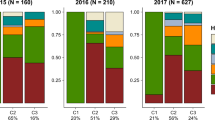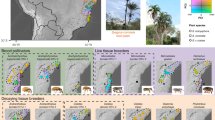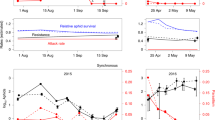Abstract
The evolution of ecological specialization generates biological diversity and may lead to speciation1,2,3. Genetic architecture can either speed or retard this process. If resource use and mate choice have a common genetic basis through pleiotropy or close linkage, the resulting genetic correlations can promote the joint evolution of specialization and reproductive isolation, facilitating speciation4,5,6. Here we present a model of the role of genetic correlations in specialization and speciation, and test it by analysing the genetic architecture of key traits in two highly specialized host races of the pea aphid (Acyrthosiphon pisum pisum; Hemiptera : Aphididae). We found several complexes of pleiotropic or closely linked quantitative trait loci (QTL) that affect key traits in ways that would promote speciation: QTL with antagonistic effects on performance on the two hosts are linked to QTL that produce asortative mating (through habitat choice). This type of genetic architecture may be common in taxa that have speciated under divergent natural selection.
This is a preview of subscription content, access via your institution
Access options
Subscribe to this journal
Receive 51 print issues and online access
$199.00 per year
only $3.90 per issue
Buy this article
- Purchase on Springer Link
- Instant access to full article PDF
Prices may be subject to local taxes which are calculated during checkout


Similar content being viewed by others
References
Thompson, J. N. The Coevolutionary Process (Univ. Chicago Press, Chicago, 1994).
Schluter, D. in Endless Forms: Species and Speciation (eds Howard, D. J. & Berlocher, S. H.) 114–129 (Oxford Univ. Press, New York, 1998).
Futuyma, D. J. & Moreno, G. The evolution of ecological specialization. Annu. Rev. Ecol. Syst. 19, 201–233 (1988).
Felsenstein, J. Skepticism toward Santa Rosalia, or why are there so few kinds of animals? Evolution 35, 124–138 (1981).
Kondrashov, A. S. & Mina, M. V. Sympatric speciation, when is it possible? Biol. J. Linn. Soc. 27, 201–233 (1986).
Rice, W. R. Selection via habitat specialization, the evolution of reproductive isolation as a correlated character. Evol. Ecol. 1, 301–314 (1987).
Schemske, D. W. Understanding the origin of species. Evolution 54, 1069–1073 (2000).
Lande, R. Quantitative genetic analysis of multivariate evolution, applied to brain: body size allometry. Evolution 33, 402–416 (1979).
Orr, H. A. The population genetics of speciation: the evolution of hybrid incompatibilities. Genetics 139, 1805–1813 (1995).
Fry, J. D. The evolution of host specialization, are trade-offs overrated? Am. Nat. 148, S84–S107 (1996).
Via, S. The genetic structure of host plant adaptation in a spatial patchwork: demographic variability among reciprocally transplanted pea aphid clones. Evolution 45, 827–852 (1991).
Filchak, K. E., Roethele, J. B. & Feder, J. L. Natural selection and sympatric divergence in the apple maggot Rhagoletis pomonella. Nature 407, 739–742 (2000).
Bush, G. L. Sympatric speciation in animals: new wine in old bottles. Trends Ecol. Evol. 9, 285–288 (1994).
Rice, W. R. & Hostert, E. Laboratory experiments on speciation. What have we learned in 40 years? Evolution 47, 1637–1653 (1993).
Via, S. & Lande, R. Genotype–environment interaction and the evolution of phenotypic plasticity. Evolution 39, 505–522 (1985).
Eastop, V. F. Keys for the identification of Acyrthosiphon (Hemiptera : Aphididae). Bull. Br. Mus. Nat. Hist. B 26, 1–115 (1973).
Via, S. Reproductive isolation between sympatric races of pea aphids. I. Gene flow restriction and habitat choice. Evolution 53, 1446–1457 (1999).
Via, S., Bouck, A. C. & Skillman, S. Reproductive isolation between sympatric races of pea aphids. II. Selection against migrants and hybrids in the parental environments. Evolution 54, 1626–1637 (2000).
Lande, R. The genetic correlation between characters maintained by selection, linkage and inbreeding. Genet. Res. Cambridge 44, 309–320 (1984).
Lynch, M. & Walsh, J. B. Genetics and Analysis of Quantitative Traits (Sinauer, Sunderland, Massachusetts, 1998).
Sun, R. Y. & Robinson, A. G. Chromosome studies of 50 species of aphids. Can. J. Zool. 44, 649–653 (1966).
Orr, H. A. Testing natural selection vs. genetic drift in phenotypic evolution using quantitative trait locus data. Genetics 149, 2099–2104 (1998).
Caillaud, C. M. & Via, S. Specialized feeding behavior influences both ecological specialization and assortative mating in sympatric host races of pea aphids. Am. Nat. 156, 609–621 (2000).
Whitlock, M. C. The Red Queen beats the jack-of-all-trades? The limitations on the evolution of phenotypic plasticity and niche breadth. Am. Nat. 148, S65–S77 (1996).
Via, S. Sympatric speciation in animals: the ugly duckling grows up. Trends Ecol. Evol. 16, 381–390 (2001).
Lander, E. S. et al. MAPMAKER, an interactive computer package for constructing primary genetic linkage maps of experimental and natural populations. Genomics 1, 174–181 (1987).
Cho, Y. G. et al. Cloning and mapping of variety specific rice genomic DNA sequences: Amplified fragment length polymorphisms (AFLP) from silver stained polyacrylamide gels. Genome 39, 373–378 (1996).
Littel, R. C. et al. SAS System for Mixed Models (SAS Institute, Cary, North Carolina, 1996).
Basten, C. J., Weir, B. S. & Zeng, Z.-B. QTL Cartographer (Version 1.13) (Department of Statistics, North Carolina State University, Raleigh, North Carolina, 1996).
Churchill, G. & Doerge, R. W. Empirical threshold values for quantitative trait locus mapping. Genetics 138, 963–971 (1994).
Acknowledgements
We thank G. Churchill, D. Schemske, D. Schluter and Z.-B. Zeng for discussions. M. Arnold, T. Bradshaw, J. Conner, K. Shaw and J. Wilkinson provided useful comments on the manuscript. Z.-B. Zeng provided the calculation from ref. 22, and R. Lande pointed out the effects of cyclical parthenogenesis on recombination rates. A. Bouck, S. Skillman, C. Olson and A. Badgley provided expert technical assistance. This work was supported by NSF and USDA grants to S.V. and D.J.H.
Author information
Authors and Affiliations
Corresponding author
Rights and permissions
About this article
Cite this article
Hawthorne, D., Via, S. Genetic linkage of ecological specialization and reproductive isolation in pea aphids. Nature 412, 904–907 (2001). https://doi.org/10.1038/35091062
Received:
Accepted:
Issue Date:
DOI: https://doi.org/10.1038/35091062
This article is cited by
-
Insight into incipient reproductive isolation in diverging populations of Brachionus plicatilis rotifer
Hydrobiologia (2022)
-
QTL mapping and GWAS for field kernel water content and kernel dehydration rate before physiological maturity in maize
Scientific Reports (2020)
-
Inter-chromosomal coupling between vision and pigmentation genes during genomic divergence
Nature Ecology & Evolution (2019)
-
Different phenotypic plastic responses to predators observed among aphid lineages specialized on different host plants
Scientific Reports (2019)
-
Genomics of extreme ecological specialists: multiple convergent evolution but no genetic divergence between ecotypes of Maculinea alcon butterflies
Scientific Reports (2017)
Comments
By submitting a comment you agree to abide by our Terms and Community Guidelines. If you find something abusive or that does not comply with our terms or guidelines please flag it as inappropriate.



